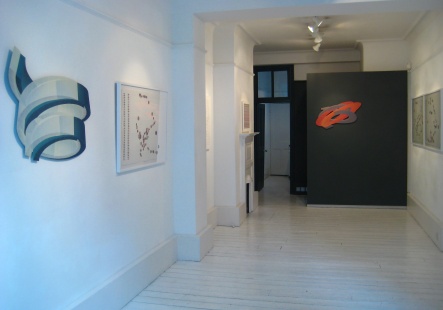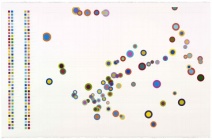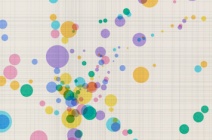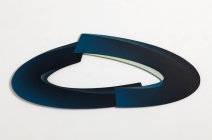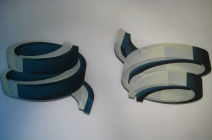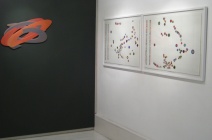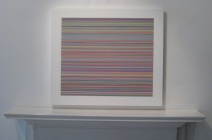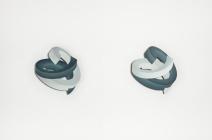The Process - Rachael Clewlow and Julia Farrer
The Process - Rachael Clewlow and Julia Farrer
The idea and its means of expression, have always been inseparable.
This exhibition of new work by Rachael Clewlow and Julia Farrer explores how two artists have developed unique processes, which not only inform, but are integral to their respective practices.
Rachael Clewlow records every journey she makes and translates this accumulated data through a complex and meticulous process into conceptual maps. Julia Farrer’s concern with geometry is fundamental to her work; the original drawings for her paintings are drawn digitally before being translated onto birch ply. These in turn transmute into asymmetrical abstract forms which transcend the boundaries between painting and sculpture.
Through rigorous and dedicated, almost ritualistic daily recording, Rachael maintains statistical diaries, which provide a detailed record of her movements and whereabouts at specific points in time. From this, Rachael produces intricate paintings and prints. In the presentation of this data, there is no emotional distinction between the arbitrary daily routine and the specific or unusual venture. It is the selection, recording and processing of this data, which is the means and subject of Rachael’s creative process. The meticulous systematic process has become a part of her life. Yet, through her style of presentation she renders the maps difficult to read; the information that defines the work is playfully disguised within complex colour systems.
Rachael explains that, “although these charts and diagrams look quite serious and informative… without explanation, they are actually unreadable.” Her diaries are exhibited in the gallery, alongside four paintings from the OS Series as well as a screen print Explorer and a piece based on the London Underground map. The Underground piece invites comparison to Harry Beck’s design, not only through their shared use of colour, line, circles and sense of harmony, but in the contrast between an accessible but geographically inaccurate rending of the tube network, and Rachael’s complex, but unfailingly accurate artworks.
Julia explores the relationship between two and three-dimensional space by creating these illusions. The exhibition includes several of her wall based paintings and prints. Julia has worked in a range of media, but her concern with structure has endured; she describes her paintings as being, “both formal pictorial structure[s] and the illusion of an architectural physical structure existing in space. They are also concerned with the transformation of that structure, twisting, rotating and reflecting the geometry using colour to alter its special orientation. The paintings are objects, being shaped panels, but the shadow they cast on the wall can be at odds and contradict the illusion of the image.” The preparatory drawings are made on a computer, which enables Julia to explore these impossible forms and lends a certain futuristic quality to these structures. She explains that process is of fundamental importance to the work as it is the vehicle that transforms idea into substance. Whilst the digital process (drawing with three-dimensional software) provides the ‘structural architecture’ of the idea, it is given physical form through techniques of painting and printmaking.”
Both artists’ work explores ideas of representing time and space in relation to form. The marks plotted on Rachael’s maps, appear haphazard and playful, even frivolous, but they directly correlate to the distances and times of her daily travels. As the points plotted on Rachael’s maps are constructed of circles surrounded by secondary circles, Julia’s shapes and forms seem to wrap around themselves; shapes and forms shift and press the boundaries between two and three dimensions. Julia shows, “perfect forms tumbling into chaos” which belie the flat surfaces, which she paints onto. Through shading and misdirection, Julia blurs illusory space and actual space. Her forms appear like an impossible Möbius strip or a sketch for a Guggenheim of the future. In Julia’s paintings, each form is divided by the slightest of lines, as if hinting to the brickwork in an architect’s sketch as she explores and plays with the rules of form. Julia’s paintings have been described by the architectural critic Andrew Mead as alluding to the Deconstructionist designs of Daniel Libeskind and Peter Eisenman ‘with their abruptly-angled walls, their folded planes, their cuts and disrupted grids’.
Consideration of colour is evident in both artists’ work, but manifests itself very differently. Each point on the map is a circle, surrounded by another of contrasting colours. Rachael explains that, “the spectrograms of colour refer to statistics or spectrums of human experience… they embody human systems for understanding/ codifying the world…and are all based on the specificity of their own experiences…” Julia’s pallet is more muted in comparison, as she layers translucent blues and greys against the white forms to imply shadow, reminiscent of the Impressionists first painting coloured shadows. These tonal relationships are an integral part of the illusion of dimension.
Both artists work with unfeasible precision, with flawless surfaces barely revealing a trace of their creator. One might imagine Julia and Rachael’s pieces to appear calculated in their perfection, but they exude a mysterious warmth. The use of subtle line and colour in each piece draws the viewer close to scrutinise the work, giving importance to surface, materials and detail.
Rachael Clewlow was a prize winner in the 2007 Nationwide Mercury Art Competition, London. She has recently been commissioned through the gallery to create over 700 prints for the new Hilton Hotel in Wembley. Rachael lives and works in Newcastle upon Tyne.
Julia Farrer trained at the Slade School of Fine Art and became a Harkness Fellow at the University of New Mexico and New York, 1974-76. In 2007 she was the winner of the Kaupthing Singer & Friedlander/Sunday Times watercolour competition. Julia’s works are in the collections of The Arts Council of Great Britain, The British Museum, Department of Prints & Drawings, Tate Gallery, Victoria & Albert Museum, La Fondation Rothschild, La Bibliotheque National and The Metropolitan Museum of Art.

